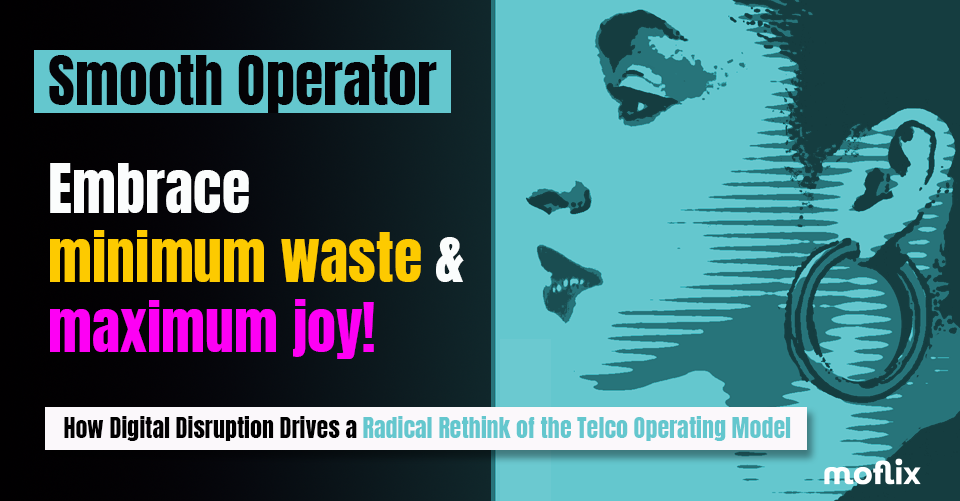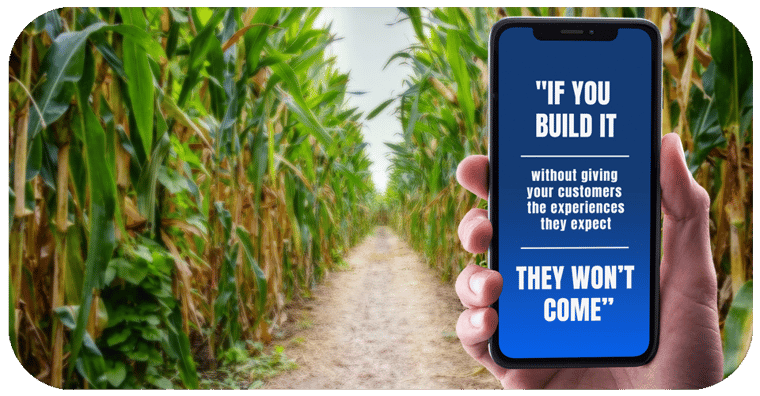Smooth Operator - Embrace minimum waste and maximum joy!

A few days ago, I had the privilege to spend some time with one of our Moflix customers. A truly happy customer, whose senior executive team members were taking half a day out of their busy schedules to provide a reference to a prospect about how they went about launching and operating an All Digital telco operator with Moflix.
This is a cause for celebration in its own right of course. It is always awesome when existing customers agree to spend time with potential new customers and share their experiences. And this customer said some very helpful things about Moflix – about our ground-breaking TelcoTech platform that allows Operators and MVNOs to launch a new All Digital Telco-in-an-App in record time; about our drive to radically simplify how telecom works by challenging decades of industry preconceptions; and about generally how amazing it is to partner with us.
You know, the usual reference call stuff, right?
But the thing that stuck with me from that afternoon, wasn’t the almost hypnotic success story, or all the nodding and smiling and warm fuzzy feelings that went along with it. The thing that stuck with me is something our customer’s CCO said to the prospect towards the end of the day, when the session was almost over, and everyone was good and ready to head to the restaurant. And it’s been playing on repeat in my head every day since:
“I recommend you invest more time on your operating model. It’s really important.”
It was music to my ears.
But why? Why have these couple of sentences stuck with me? Why is it really important?
It’s simple: the operating model is where the rubber hits the road. It’s what being a successful All Digital operator is all about. It’s because in amongst all the necessary excitement about cloud-native platforms, app-first engagement, and agile development cycles, we often lose sight of the fact that the single biggest benefit of digitalizing the way the telco industry works is derived from radically rethinking the telco operating model. It is where all the cost savings are realized, where the organizational synergies are to be found, and where new revenue opportunities can be unlocked.
It is something that we bang the drum about here at Moflix with an almost religious zeal. And it’s great to hear a customer just come out and say it - unprompted - based on their own real-world experience of doing digital properly in the telecoms industry.
The truth is this: A good digital platform will give you new capabilities; a good digital brand will get customers through the door; and a good digital app will bump up your Trustpilot ratings and boost your Customer Lifetime Value. But the real value comes from having the confidence to embrace the brave new world of the digital operating model.
In comparison to how telcos are used to working, the digital operating model is lean. Ridiculously lean. We have gotten used to almost every function in our organizations being built on the backs of armies of people. This is something we have in common with many businesses, especially in industries that have been around for any length of time, and the working assumptions on which a company’s operating model may have been structured 30-40 years ago could have had no foresight of the technological innovations that have impacted the world so disruptively in the last 10 years.
The concepts of in-pocket digital self-service and engagement, and the widescale systemic automation of customer interactions and business processes necessary to enable them, would be alien to all but the newest and most enlightened MBAs or a few wise old campaigners in the boardroom who understand that change is the only true constant in the world of business.
And the slow pace of digitalization in many industries has reflected this to a large degree. As we noted in our very first blog post on this subject: it is pretty much impossible to disrupt your industry if you don’t have the tools to disrupt your own thinking. And for many senior execs it simply isn’t in their DNA.
But in the telco industry we have a special kind of challenge. A special kind of labyrinth in which lurks a Minotaur of our own making.

You see, we invented the concept of voice calls, and we invented the telephones that enable them. And we invented them nearly 150 years ago! Our early connectivity model, which relied on the human operator to physically connect the A and B parties through a switchboard, pretty much foreshadowed the development of the modern call center, and the armies of people we employ to sell to and service our customers. This human-centric voice-centric way of interacting with people is a thing we cling to with particular tenacity in the telecoms industry. We’re doing things the way we’ve always done them. And we’re doing it with our own technology.
Which is all well and good. Except the way the world works has changed. And the people we sell our services to have completely different expectations. They don’t want wait on hold, then hang around on the phone talking to your ever-so-friendly-and-convincing customer care team. They certainly don’t want to have to visit a shop. They just want to press a few buttons in an app on their smartphones and get stuff done right away. Like they do in pretty much every other aspect of their lives.
As telco execs, we have a stubborn resistance to seeing things through the eyes of our customers and what is good for them. Our industry was brought into existence on a wave of 19th Century technological innovation which carried with it a “build it and they will come” mindset that prevails to this day. An operator-centric view that says: “We know what is good for people. They will put up with the way we do things just to take advantage of our advanced communications technology prowess “ – a view which, by the way, was repeated with rather stomach-churning arrogance by a well-known UK operator at an industry conference we attended late last year.

On this occasion though, we’ve dropped the ball. We’re so busy congratulating ourselves on coming up with the standards for the next G of mobile or endlessly tweaking our programmable network-as-a-service offerings, that we have failed to see the way we service and engage with our customers has hardly changed, while the rest of the world has moved resolutely on.
The modern digital service providers that run rings around incumbents in many industries have been born without any of the baggage of “this is the way we always did things”. And those operators in the telco industry who are doing a good job of managing the transition to digital have learned some lessons from this.
As we’re fond of saying here at Moflix: “If you are going to start a new telco in 2023, you’ll do it very differently from how you would have done it in 2003”. And this goes far beyond evolving the current retail and call center-centric operating model through a process of “digital transformation”. A modern lean digital telco needs to step back and reimagine the entire way of doing business.
A modern lean operating model is predicated on a channel blend that leans heavily on highly automated digital self-service as the primary way of both going to market and servicing existing customers. It presupposes a small expert team of specialists who can help customers with any aspect of the digital customer journey that they can’t work out for themselves, or who are there as the "support function of last resort" in case the systems aren’t working as they should. This transition in thinking alone can be responsible for reducing the number of people involved in servicing customers from thousands down to 10-20 FTEs, even in a large “Tier 1” telco, along with the related reduction in facilities and infrastructure costs.
Another key enabler for a lean digital operating model is commercial simplification. Why employ 150 people in marketing to offer a telco connectivity offering in the 21st century? Keep it simple and follow the lead of service providers like Netflix who have a subscription model that everyone can understand. I shouldn’t have to be able to explain it to you like you’re 5 – your 5-year-old can already use Netflix, and your 10-year-old probably already has a WhatsApp account! Our customers have teams of fewer than 5 people running the whole of their marketing operations. It makes the whole rationale for large risk, fraud and revenue assurance teams seem a little weak too, doesn’t it?
And while we’re at it, just imagine an operating model that meant we didn’t have to ship pieces of plastic to our customers every time they wanted to sign up for a mobile subscription. Imagine the cost savings in manufacturing & logistics... imagine the manpower savings from not having to deal with lost SIMs and botched activations... imagine the sustainability benefits of not having to dispose of all that plastic. If only there were some technology available that made it possible to activate a mobile subscription from anywhere in the world simply by downloading a subscriber profile directly to a phone. Like an embedded SIM – an eSIM if you will!?
Only by being prepared to embrace some uncomfortable choices and slaughter some of our sacred cows can we release ourselves from the tortuous maze of digital transformation in telecoms. We will never realize the full benefits of all these digital technologies that enable new business models or reach parity with other service providers as a valued part of people’s digital lives if we don’t allow ourselves to step back with humility and recognize the extent to which we need to change. Becoming a successful All Digital telco requires us to reexamine our operations through the lens of what’s good for the 21st Century customer, not just what worked for the 19th Century network operator.
On this occasion, technology alone isn’t going to fix things. It’s time to invest more time on your operating model.
It’s. Really. Important.
If you would like some additional reading on this, we highly recommend McKinsey & Company's excellent "A Blueprint for Telecom's Critical Re-invention."

This is Part 4 of a 10 part series on digital disruption in the telecommuncation industry. We will update the links as new content is published.
I. Telco Disruption Introduction: "Disrupt or Die. The Digital Clock is Ticking"
II. Disruption of Markets: "Are You Sitting Comfortably? Then It's Time to Get Disrupted!"
III. Disruption of Customer Engagement & Experience: "Dear Telcos...Fast, Cheap, & Easy is a Good Thing"
IV. Disruption of Operating Models: Smooth Operator: Embrace Minimum Waste and Maximum Joy!
V. Disruption of Culture
VI. Disruption of Success Metrics
VII. Disruption of Working Practices
VIII. Disruption of Solution Architectures
IX. Disruption of Technology Assumptions
X. Disruption of Procurement Approach